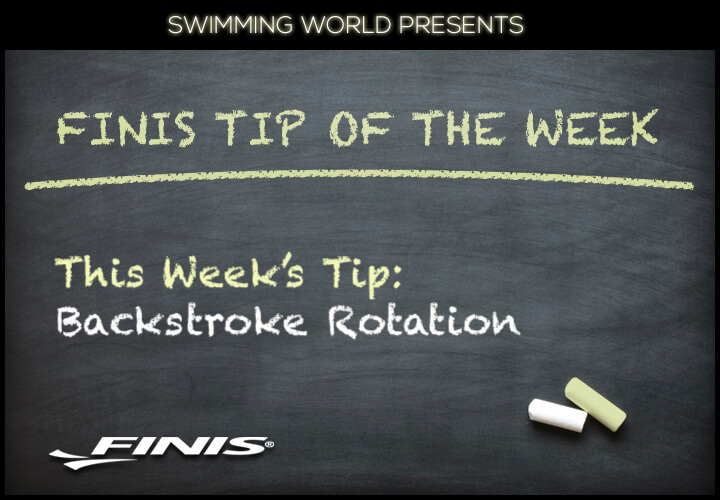FINIS Tip Of The Week: Backstroke Rotation

Welcome to the “FINIS Tip of the Week.” Swimming World will be bringing you a topic that we’ll explore with drills and concepts for you to implement with your team on a regular basis. While certain weeks may be more appropriate for specific levels of swimming (club, high school, college, or masters), each tip is meant to be flexible for your needs and inclusive for all levels of swimming.
This month’s tip series is on backstroke. Last week’s tip focused on the hand entry in backstroke, and this week will focus on an essential piece of a strong backstroke: rotation. If your rotation is out of sync it can throw off your stroke tempo, the entry and exit of your pull, and ultimately negatively impact the efficiency of your stroke. Take a look at the tips and drills below that can get you a better rotation for a faster backstroke.
Hips And Shoulders Together…
One of the most important elements of backstroke rotation is making sure that the shoulders and the hips are rotating together. Rotation helps to drive the tempo of the arms, and any lag or lapse in the timing of your rotation is going to decrease the efficiency of your stroke.
A great cue to help swimmers understand this concept is to have them think of their backs as the bottom of a boat. As they rotate, it should feel like their entire torso is rocking from side to side. This requires a certain degree of core control and body awareness, so work on incorporating drills into your backstroke work that play around with these concepts.
Good drills to work on timing the hips and shoulders rotating together include shoulder to chin kick with the arms at the side or single arm backstroke where you are watching specifically for even rotation on the “ghost arm” side.
Timing With The Stroke…
As mentioned above, body rotation drives the arm tempo in backstroke, so you want to make sure you are rotating in sync with the stroke. As the pinky side of hand enters the water, the same side of the hip and shoulder should be rotating down. As the pull is finishing and the arm is leaving the water, the hip and shoulder should be driving up.
If the rotation is too slow the arms won’t be in a position to set up an effective pull, essentially making the swimmer play catch up as they slip through the water and have a slower tempo that is driven by poor rotation. L drill is a useful drill to work on coordination between the pull and body rotation, forcing swimmers to check in with their kick, core, and body position.
Don’t Over-Rotate…
When talking about and working on rotation in practice, be sure to stress that more is not necessarily better. While many young and beginning swimmers will be under-rotating, you can just as often see swimmers who will be over-rotating.
The major problems with over-rotating include slowing down your stroke tempo, forcing a deeper and ultimately less effective pull. A more severe rotation on each side also means there is more of an opportunity to lose the connection between your shoulders and your hips in your rotation.
All swimming and dryland training and instruction should be performed under the supervision of a qualified coach or instructor, and in circumstances that ensure the safety of participants.




??? ❤ BOT CREATED BY ❤ @.[100013484740647:2048:]
❣ ??? ???
? BOT CREATED BY Rafiq Afridi 🙂